Some five ounces of clear fluid fills the spaces between your brain and your skull. This brain juice, or cerebrospinal fluid, cushions against injury, supplies nutrients and clears away waste. Your body can make as much as a pint of fresh stuff every day to replace the old.
But for 150 years, scientists have puzzled over how the used cerebrospinal fluid leaves the brain to make room for more. New research, published Wednesday in Nature, has finally deciphered this brain drain process. As a result, it’s also inching us closer to and other neurodegenerative diseases.
South Korean scientists, led by Gou Young Koh, completed the puzzle by studying our immune system’s superhighway, dubbed the lymphatic system. They were able to trace the cerebrospinal fluid’s one-directional path in mice, from its origin in the brain into lymph nodes in the neck. The key conduit? Lymphatic vessels at the bottom of the skull, in the brain’s outer layers.
Keys in Cerebrospinal Fluid
Before now, neuroscientists thought cerebrospinal fluid drained through lymphatic vessels on top of the brain or ones exiting through the nasal cavity. No one had managed to carefully examine the lymphatic vessels on the bottom of the brain because they’re so close to bones and delicate blood vessels.
But by having a neurosurgeon on their team, the researchers could get close enough to identify what was so special about these bottom lymphatic vessels and see what makes them ideal for draining cerebrospinal fluid.
These details provide evidence for the vessels’ role in Alzheimer’s disease. One of the substances thought to cause Alzheimer’s, beta-amyloid, is washed out of the brain by cerebrospinal fluid. Scientists believe beta-amyloid accumulates and forms plaques in older people because our ability to replace cerebrospinal fluid slows down with age.
Read More: Beta-amyloid and Tau: What Do These Proteins Have to Do With Alzheimer’s?
And these lymphatic vessels identified in the new research contribute to the slower flow. The researchers found that the vessels were much more branched in older mice, spreading out the cerebrospinal fluid instead of channeling it straight to the lymph nodes in the neck. The vessels were also bigger in diameter, which lowered the pressure and decreased the flow rate just like in bigger blood vessels.
“This finding might eventually enable the development of therapies that promote [brain and spinal cord] drainage to combat pathological processes in neurological diseases,” Taija Mäkinen, an immunologist not involved in the research, wrote in an accompanying commentary piece.
Koh and his team are now trying to replicate their findings in primates and humans. This work could lead to a drug that helps the body make more cerebrospinal fluid and also drain more of the old liquid, helping crack the current conundrum of Alzheimer’s disease.
Read More: What You Need to Know About the 6 Stages of Alzheimer’s Disease














